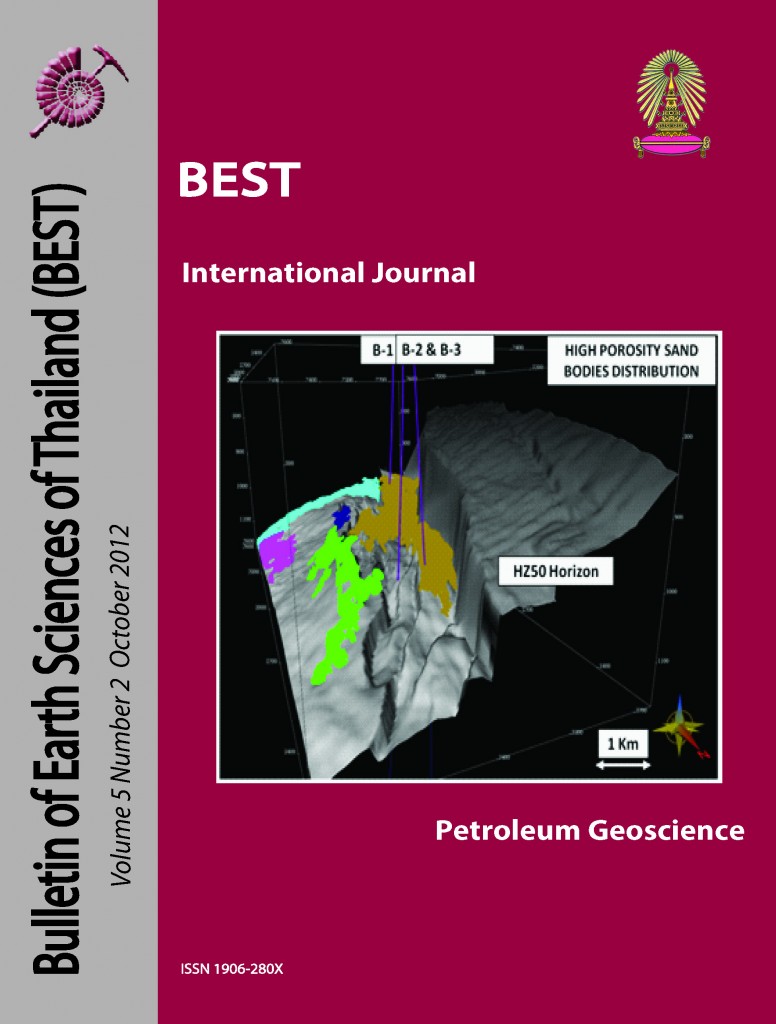Lithology Prediction Using Rock Physics Analysis and Seismic Inversion within Miocene Fluvial Reservoir Interval in the Songkhla Basin, Gulf of Thailand
Main Article Content
Abstract
The study area is located within the Songkhla Basin and lies in southern area of western part of the Gulf of Thailand. The reservoirs in the Songkhla Basin are fluvial sands. These reservoir sands are compartmentalized and show rapid lateral stratigraphic changes due to their fluvial nature and it is not easy to map reservoir sands by using conventional seismic data. Rock physics analysis and seismic inversion techniques were applied to map the distribution of reservoir sands within the Miocene interval. Rock physics analysis shows that P-impedance can only differentiate porous sands (total porosity > 22-24%) from shales, while low porosity sands have same P-impedance as of shales. Porous sands have low Pimpedance (less than 7000 g/cc*m/s). Moreover, relatively low porosity (total porosity up to 18-22%) sands can be detected by using P-impedance and Vp/Vs information in combination. P-impedance volume was computed through post-stack seismic inversion and the results are in reasonable match with the Pimpedance logs at three well locations. Similarly, simultaneous inversion was performed to compute Pimpedance and Vp/Vs. The results were checked by different QC parameters. Sand bodies were captured by using computed thresholds of P-impedance and Vp/Vs volumes. Most of the sand distribution is restricted within the faulted zone and it appears that sedimentation was controlled by structural configuration of the basin. Present study reveals that post-stack and simultaneous inversion can successfully map the lithology heterogeneity within the Miocene reservoir interval in the Songkhla Basin.
Article Details

This work is licensed under a Creative Commons Attribution-NonCommercial-NoDerivatives 4.0 International License.
Copyright © 2008 Department of Geology, Faculty of Science, Chulalongkorn University. Parts of an article can be photocopied or reproduced without prior written permission from the author(s), but due acknowledgments should be stated or cited accordingly.
References
Kartikasari, H.A., 2011, Structural style of Songkhla basin, Gulf of Thailand: M.Sc. thesis, Chulalongkorn University, 63 p.
Oldenburg, D.W., T. Scheuer, and S, 1983, Recovery of the acoustic impedance from reflection seismograms: Geophysics, v. 48, no.10, p. 1318-1337.
Pendrel, J.V., and P. van Riel, 1997, Methodology for seismic inversion and modeling- a western Canadian reef example: Canadian Society of Exploration Geophysicists Recorder, v.22, no. 5.
Pendrel, J.V., 2001, Seismic inversion-the best tool for reservoir characterization: Canadian Society of Exploration Geophysicists Recorder, v. 26, p. 16-23.
Ronghe, S., and K. Surarat, 2002, Acoustic impedance interpretation for sand distribution adjacent to a rift boundary fault, Suphan Buri basin, Thailand: AAPG Bulletin, v. 86, no. 10, P. 1753-1771.
Russell, B.H, 1988, Introduction to seismic inversion methods: SEG Course Notes Series, no.2, 90 p.


